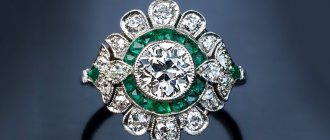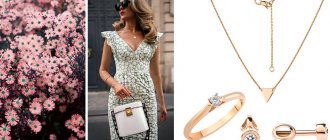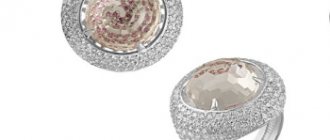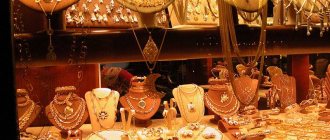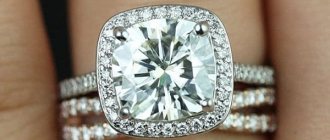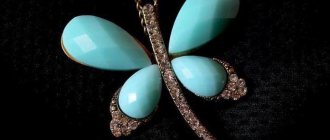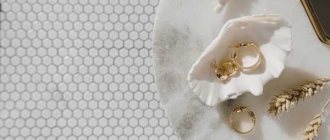RINGS EARRINGS BROOCHES BRACELETS CUFFLINKS NECKLACE TIADE
From time immemorial, people have been drawn to true works of art. The works of jewelers, in which the natural beauty of precious materials was combined with the perfection of forms created by the hands of goldsmiths, invariably aroused admiration. Already from the very beginning, wholesale jewelry that complemented a person’s costume was so perfect and diverse that subsequent generations from time to time opened this ancient treasure chest, drawing ideas, style, and forms from it. Necklaces, earrings, combs, mirrors, rings, rings, medallions, brooches, brooches, hairpins, hairpins, bracelets... Since ancient times, the assortment of jewelry has been rich: like paints from an artist’s palette, they can recreate the ritual of a person’s rivalry with the inexorable time and his a dream of your own ideal image...
Ring
A ring is a piece of jewelry consisting of a ring (rim) and a shield (or without it), known since ancient times. Initially, the ring determined the social status of the owner; it was used to affix a mark (seal) on documents and items of property. In Ancient Egypt, rings were known in the form of a drilled carved signet mounted on a wire rim that could be worn on the finger. Among the peoples inhabiting the Mediterranean and the territories of the Near and Middle East, rings have served as jewelry since ancient times. And in ancient Rome, the ring was a sign of belonging to a noble family - the patricians. Muslims consider it obligatory for men. No wonder Eastern wisdom says: any decoration can be, but a ring is a must. The shape and nature of the decorative decoration of the rings changed over time, and the symbolism became more complex. They were made of bronze, silver and gold, decorated with carvings, graining, enamel, colored stones and diamonds.
Historically, there have been several types of rings that retain their meaning to this day. Already in the 12th century. engagement rings appeared, serving as a guarantee of future love and family relationships. Nowadays, they are decorated with diamonds symbolizing eternity and the indestructible strength of the union, as well as the purity of thoughts and intentions of those entering into marriage. At the end of the 18th century. In Russia, with the legislative registration of the ceremony of betrothal and wedding, wedding rings, worn during the Orthodox wedding ceremony on the ring fingers of the right hand of the bride and groom, became widespread (for Catholics and Protestants, the ring is put on the left hand). Traditionally, a smooth engagement ring symbolizes the eternity of marriage. However, recently, more and more often there are ceremonial rings, which are a shank that is even around the entire circumference, decorated with diamonds or precious stones of the same size and cut. Other types of rings become popular from time to time. So, fashionable in the 1920s. Trinity ring with a triple shank, each of which has a symbolic meaning: love, friendship, fidelity, reappeared on the shelves of jewelry stores in 2007. Sometimes romantically minded men and women, as a reminder of people close and dear to them, wear the ring on their chest, hanging it like a talisman. Recently, mainly among young people, piercing rings have found their fans.
Gothic style
Silver necklace from VaeNoxx (vaenoxx.deviantart.com)
The Gothic style in architecture that appeared in the Middle Ages was immediately reflected in jewelry. The products acquired symbolism, became massive and embossed. A play on contrasts began to manifest itself - red stones and blackened silver, black stones and gold.
Today, the Gothic style has many interpretations. Many consider it to be purely youthful, although this is absolutely not the case. Some jewelry is indeed in demand exclusively by representatives of subcultures - “vampire” rings, skulls with diamonds, crosses. But there are also “softer” trends: Gothic Renaissance, jewelry in a contrasting style.
Advertising - Continued below
Earrings
Almost everywhere among the peoples inhabiting Europe, the Middle East, the Caucasus and Southeast Asia, earrings were known already in the 3rd-2nd millennia BC. The classical antiquity of Greece and Rome presents a rich variety of their forms and decoration. In the ancient Black Sea region (IV century BC - IV century AD), gold earrings-discs with relief images of lion heads and griffins, as well as rosettes, sometimes colored with enamel, became widespread. There are known ring earrings with end decorations in the form of heads of animals, maenads, blacks, and the figure of Eros. In the II century. The Sarmatians appeared earrings with miniature pendants - amforms, and in the 3rd century. – drop-shaped with numerous colored glasses. These decorations are found in both female and male burials, but male nomads only put the earring in their left ear. Renaissance fashion gave new life to various types of earrings. Jewelers put endless imagination and skill into their production. Jewelry with large pear-shaped pearls was especially prized. Earrings appeared, decorated with stones on the front side and enamels on the back side. In the Baroque era, jewelry began to be made in entire sets - parures, and earrings were certainly included in their composition.
With the era of classicism came a passion for strictly shaped earrings with drop-shaped pendants, cameos or their imitations made of ceramics or papier-mâché. Just like bracelets in the 1930s and 1940s. earrings were made of cast iron. The Biedermeier style brought pendants made of polychrome gold into fashion. The traditional type was also in use in the form of a colored gemstone in a filigree frame with grain. Large long earrings were worn mainly with a decorated dress that exposed the lady's shoulders and neck.
In the 1020-1930s. miniature stud earrings appeared. (studs) secured in the earlobe with a screw or pin. Since the late 1930s. Clip-on earrings came into fashion. They were held in place with clips and did not require earlobe piercing. The modern selection of earrings is rich and varied - from very miniature to traditional roll earrings, gypsy rings and very large ones, with a whole stream of pendants in the form of chains, coins, “charms” and stones of all types of cutting and processing.
Classic style (classicism)
Tiara made of gold with diamonds, pearls and enamel, XVIII-XIX centuries.
The style replaced Rococo. Luxury and excessive pretentiousness began to tire people; they wanted simpler and more understandable forms. Thus, in the second half of the 18th century, the classical style arose. The main features are antique ornaments, clear lines, geometric patterns, complete symmetry.
The style lasted only a few decades, but left a visible mark on jewelry. Restrained decor, integrity of forms, simple lines - all this is still popular today. A classic-style ring was either smooth or with an unobtrusive floral or geometric pattern, often with one large stone. By the beginning of the 19th century, decorations began to lose the characteristic features of classicism and again became more magnificent and luxurious. However, it was from the jewelry of the classicism period that modern classical jewelry was born.
Brooch
A brooch is one of the oldest decorative elements of costumes of people of all times and peoples. The ancestor of the brooch is considered to be the fibula, which was used by many peoples of the world. The loose and fluffy Renaissance costume made the brooch an indispensable accessory. They were worn by people of different classes - bronze cast ones decorated the modest clothes of the common people, and wealthy nobility ordered precious brooches from jewelers. They were sewn not only on clothes, but also on hats. Thus, in the portrait of the English king Henry VIII by Hans Holbein the Younger we see eight large gold, richly decorated brooches sewn onto the folded brim of the royal hat.
The wide distribution of these jewelry was suggested by the 17th century. The brooch again acquired its utilitarian meaning. With its help, they fastened the collar, gathered the folds of clothing or reduced the neckline, as was done by one of the court ladies of Louis VIII, Madame de Sevigne, whose name has since been borne by this type of brooch. Rubies, emeralds, sapphires, and pearls were used to decorate them.
In the 18th century Diamond brooches appeared in the form of various flower bouquets and bows. At the end of the century, brooches with enamel miniatures, often portraits, became widespread; Cameos and intaglios carved on stone or lava in a strict frame with a needle-shaped lock. They were often replaced by ceramic cameos, which then became fashionable, created at the manufactories of the English ceramic artist Josiah Wedgwood.
Boho style
Boho style jewelry.
Photo: 7colorz.com The style appeared in the 60s of the 20th century during the times of hippies with their free lifestyle. Its features: simplicity, natural materials, layering, pastel natural shades. Boho jewelry often uses ornamental stones, wood and silver. Originality and ethnicity are visible in every product.
Bracelet
A bracelet (from the French bracelet - “wrist”) is a solid, detachable or consisting of links decoration, which is most often worn on the wrist. It has been worn since ancient times, by both women and men. Plate bracelets made of mammoth ivory, made more than 25 thousand years ago, date back to the Paleolithic era. Metal bracelets appeared in the 3rd millennium BC. Throughout history, they were made from a variety of materials: bronze, iron, glass, faience, silver, gold, and later, from the end of the 19th century, from platinum. The shape of the bracelets changed - flat, voluminous, curly, they were decorated with filigree, engraving, enamel, pearls and precious stones.
The shape of the bracelets and their location changed over time. Following fashion, even European women wore bracelets and chains on their ankles. The thin silks of ballroom dresses that developed in the dance slightly revealed the graceful legs of the dandies of the times of Alexander I with this piquant gold decoration. After the excavations of Pompeii in the mid-18th century. Interest in antiquity revived the fashion for bracelets. Now cameos and intaglios could often be seen on them. Aristocrats, carried away. Like Catherine II, collecting minerals made jewelry with acrograms popular: stones for them were selected in such a way that a name or motto could be formed from the first letters of their French names. Such bracelets with the encrypted name of Paul I and his children were kept by the emperor's wife Maria Feodorovna. Nowadays, bracelets have become one of the sought-after jewelry items. In the collections of jewelry companies, they are presented in a variety of forms and decorations - from thin rivieras (English: “stream”, “river”), showered with diamonds, to numerous chain compositions with pendants made of metal and stone.
Rococo
Gold-plated silver bracelet from Tom Binns
At the beginning of the 18th century, when the unique technique of working with metal “mokume gane” was developing in Japan, the Rococo style reigned supreme in France. It has similar features to the Baroque style, but the Rococo decorations are more fluid and asymmetrical. New elements appear - curls, roundness. The name of the style itself comes from the word “rocaille” - an ornament repeating the curl of a shell.
By the middle of the 18th century, the style spread throughout the cities of Europe. Ladies and gentlemen of those times liked the sophisticated, graceful jewelry, light, ornate. The straight ribbons in the decor became twisted, the leaves became thin and curved, the petals in buds became lush.
Cufflinks
It is believed that the first cufflinks appeared at the turn of the 16th-17th centuries. in France. It was then that the cut of the sleeves of men's shirts changed: to tighten them, small slits began to be made in the cuffs, through which a pair of identical buttons connected by a chain or wire were threaded. At first they were called cuff buttons, and a little later cufflinks. The widespread use of cufflinks began in the mid-19th century. with the advent of the modern look of shirts with stiff cuffs. They are usually worn with both business and evening suits. Depending on this, cufflinks are made from various (including precious) materials, and the design uses engraving, filigree, niello, and enamel. At the turn of the XIX-XX centuries. There was a mandatory ceremonial set of men's jewelry - a pin for a tie or scarf, buttons, sometimes complemented by a ring, and of course, cufflinks. And at the beginning of the 20th century, when shirt-cut blouses appeared, women began to wear them.
The decor of cufflinks has changed several times over the past 100 years. In 1920-1930 On the cufflinks, horse racing and sports cars coexisted with scenes and trophies of hunting and fishing. In 1960, ethnic motifs inspired by hippie culture were added. In the middle of the 20th century. 2 types of cufflinks were finally formed - European, with identical decoration of both halves, and American, simplified, with decoration of only their front part and small hinges and loops. Nowadays, cufflinks are still relevant, and this is due to the formation of a new psychology, according to which a suit, jewelry and accessories provide an external characteristic of a person’s status in society.
Baroque style
Baroque brooches from Pierre Bex
The great sculptor Michelangelo is considered the “Father” of the Baroque style. The main features of this trend - an abundance of elements, bright colors, lines flowing into each other - are also reflected in the decorations.
Europe in the 17th and 18th centuries was experiencing turmoil. Tired of the tense situation, citizens wanted to somehow get distracted. And so jewelers began to produce the first openwork brooches and buckles with an abundance of pearls, which, by the way, were also used in costumes. By the way, Russia also has its own famous openwork technique - filigree (also known as filigree), which originated in the 10th-12th centuries.
In the Baroque style, previously popular pendants practically disappeared. They were replaced by new models of jewelry - multi-tiered bracelets, “candelabra” earrings, rings with “secrets”.
Advertising - Continued below
Necklace
A necklace (French collier – “collar”, “necklace”) is a fairly voluminous decoration for the neck and chest with a fixed and effectively designed central part, which differs from a necklace. However, recently the boundaries of both definitions are often blurred. A necklace can consist of one or several rows of decorative elements, the volumes of which, as a rule, increase towards the center, although asymmetrical compositions of a fantasy nature are also known. Necklaces are often complemented with pendants made of precious stones or large pearls. Unlike the half-choker, which is a relatively small decorative element in the center, the necklace occupies the entire upper part of the chest, turning into a thin strip at the level of the neck and shoulders.
Unlike a necklace, the choker came into use only during the Renaissance. Then it was part of both women's and men's formal dress, and the men's necklace was worn over clothing. It was massive and ended with a large pendant - a medallion. The types of necklaces, their sizes, lengths, and decorative elements are associated with changes in fashion and style trends characteristic of certain eras. In the 17th century The so-called sklavages, which tightly fit the lady’s neck, became widespread. The name of this comes from the French. esclavage – “slave”, “slave collar”. It is associated with the flirtatious cult of the god of love Cupid, whose slaves the representatives of the fair sex of the refined and gallant age jokingly declared themselves to be. These necklaces were made of gold, complemented with precious stones; sklavages were known in the form of gathered lace ruffles or velvet. A luxurious pendant or bow was located in the center.
Throughout the 19th century. Several types of necklaces appeared that have not gone out of use to this day. Since the 1830s ladies are happy to wear rivieras - necklaces composed of repeating links of the same decoration: emerald, sapphire, with cameos or mosaics. At the turn of the XIX-XX centuries. Necklaces came into fashion - lavalieres in the form of a chain with a drop-shaped or pear-shaped pendant made of a precious stone in a frame or without it. In the Mogerna and Art Deco eras, sautoirs were worn - jewelry with a group of pendants or a tassel on the chest. These pendants were made from beads, pearls or chains of the same length.
In parallel with all the fashion trends that follow each other, the world's leading jewelry houses offer their clients exclusive necklaces and intricate necklaces that continue the traditions of classic styles. The variety of shapes, decor and the wealth of materials used for these decorations are limited only by the imagination of the designers and... the size of the customers' bank accounts.
Branding of jewelry
All products made of precious metals manufactured in our country must have an assay mark issued by the Assay Supervision Inspectorate of the Ministry of Finance. The hallmark contains the sample, indicated by numbers.
In addition to the metric system used in our country, a number of countries use the carat system. The correspondence of some samples of gold alloys of the two systems is given below:
| Metric | Carat |
| 375 | 9 |
| 583/585 | 14 |
| 750 | 18 |
In addition to numbers, the stamps of some countries also contain symbols. For example, until recently, on domestic products, a star with a hammer and sickle was depicted in front of the numbers.
If the Assay Supervision Inspectorate establishes a discrepancy with the sample specified on the product, then the product is marked NP (does not correspond to the sample). These products are recyclable. Along with the hallmark, the product is marked with the name of the manufacturer, containing the last digit of the year of manufacture and the conventional letter designation of the enterprise.
Diadem
“Diadumen” - this is how the sculpture of the great sculptor of antiquity Polycletus (5th century BC) is signed. It depicts a young man tying a winner's bandage around his head. Indeed, in ancient times, a diadem was a headband made of fabric of the usual white or blue color, often decorated with ornaments. The diadem-bandage was also used as a symbolic headdress of eastern monarchs, Jewish high priests and ancient Greek priests. Tiaras were especially popular during the Hellenistic period. Subsequently, the diadem became a symbol of royal power and took on the appearance of a crown. Now, in its manufacture, exclusively precious materials were used: gold, pearls, diamonds. Over time, the crowns of the Byzantine emperors were supplemented with multi-row pendants - cassocks. They were attached to the sides of the face.
In the 18th century With the fascination with the art of antiquity, tiaras became an indispensable element of ladies' ballroom attire. Sometimes they resembled an elegant flower garland, fixed in the curls of the hairstyle. This is what the tiara looks like, stored in the Diamond Fund of Russia. It is composed of seven movably connected links in the form of roses and fredorang, strewn with diamonds with small bees, as if hovering over their cores. The unknown jeweler who made this decoration for Empress Elizabeth Petrovna placed colored foil under the sparkling stones, creating the impression of natural colors.
The tiaras of classicism were a rim with a middle part raised high above the forehead. A peculiar continuation of the evolution of the diadem in the era of historicism was the appearance in the Russian official court women's costume, adopted in the mid-19th century, of a head adornment in the form of a stylized kokoshnik.
* There are gems with inset images (intaglios) and with bas-relief convex images (cameos). Since ancient times, gems have served as seals (signs of ownership), amulets and decorations.
17.07.2012
Art Nouveau or Art Nouveau style
Art Nouveau pendant by Luis Masriera
In the 90s of the 19th century, Art Nouveau (Art Nouveau) became popular - a new art that originated in Russia and France, and later conquered all of Europe. At first, jewelry in this style had Gothic and Japanese features or were made in a floral style (the use of floral and plant patterns). The style quickly became popular due to its brightness, imagery, and abundance of decor.
Advertising - Continued below
Many consider Art Nouveau a paradox in the jewelry craft because of the mixture of different styles: in Russia, Art Nouveau develops along with national techniques, and French masters focus on Japanese motifs. All this led to the fact that Art Nouveau decorations were unusual and unusual for those times.
At first, products in this style were created only for wealthy people in a single copy. In addition to plant themes, they began to use images of mythical characters, silhouettes of people, birds, and animals. Various jewelry enamel techniques were actively used.
The nuances of choosing jewelry for clothes
Many women are interested in what types of jewelry should be chosen with everyday clothes. Here you must be guided by the following rules:
- One style for clothes and jewelry. Inexpensive plastic jewelry will suit the look of a teenage girl. If a woman prefers ethnic style, then it is better to choose wooden or leather products. Office workers can give preference to small silver or gold pendants.
- The color of accessories can be either contrasting with clothing or supporting the tone of the clothing. If you still choose contrasting jewelry, then there should be a couple more elements to match it. On its own it would be somewhat inappropriate.
- The color or pattern of the garment. For a monochromatic ensemble, intricate compositions with various components are suitable; for a motley or colorful outfit, these should be single-color compositions.
- “Modest” jewelry matches the original style of clothing. This could be an asymmetrical robe or the presence of many different details on it.
- Plus-size ladies should give preference to medium-shaped jewelry, since large ones will only make the look heavier. Delicate and elongated pendants are suitable for petite women.
- You can wear bracelets under a blouse or dress with three-quarter sleeves, as well as long knee socks, which will look great regardless of a woman’s body type.
Recently, the ancient tradition of wearing rings and bracelets over gloves has been revived. Despite its popularity, such an ensemble does not look very aesthetically pleasing.
Subtleties of choosing jewelry
Being a mandatory addition to clothing, regardless of style, jewelry adds a touch of elegance and charm to the image. In order not to make a mistake with your choice and achieve ideal results, it is important to take into account several design rules:
- Combination with clothes. Jewelry should always match the type and style of the outfit. For example, you should not complement an expensive evening dress with cheap jewelry. In this case, only luxury or jewelry products would be appropriate.
- Color solutions. It is strictly not recommended to combine silver and golden shades in one look. You'll have to choose one. At the same time, the decoration itself can repeat the color of the clothing, complement it, or, conversely, create an expressive contrast.
- Features of the figure. When choosing jewelry, you should remember that it will attract attention to its location. Thus, by correctly placing accents, you can emphasize the advantages of the figure, leaving the shortcomings unnoticed.
- Jewelry size. The larger the body, the larger the decorative items should be. Clothing material. The denser the fabric of the outfit, the more massive the jewelry should be worn with it.
***
Today, when creating stylish and unique images, jewelry lovers are increasingly giving preference to costume jewelry. Thanks to their high quality and affordability, such products allow you to make a lasting impression in any situation, regardless of age and physique.
How to do it yourself?
Due to the availability of all kinds of master classes, as well as the availability of various kinds of haberdashery, fashionistas prefer to create real masterpieces on their own. In addition, such unique things look not only primitive and expensive, but also very original.
Types of DIY decorations:
- Velvet. To make it you will need velvet braid or a strip of thick satin. The size of the ribbon is equal to the length of the neck circumference + 2 cm. You will also need a pendant that will be attached in the middle of the product. Fasteners are installed on the ribbon at the back, and the strip of fabric itself can be additionally decorated with beads, multi-colored stones or rhinestones.
- Lace choker. To make it you will need lace of small width, a lock for the clasp, and also, if desired, pebbles or beads. A strip of lace is cut to the required length so that it fits as tightly as possible to the neck. Additionally, you can decorate a plain fabric with pebbles or rhinestones in a contrasting color.
- Ribbon necklace. We take a bright satin ribbon (up to 1.5 cm wide) and many small rings (up to 15 mm in diameter). The length of the ribbon should be 20 cm longer on each side than the diameter of the product, since then the edges will be tied into a bow. The fabric is alternately threaded into rings, and at the end everything is secured with a knot. The ribbon is tied in a bow at the front. The decoration looks quite impressive and fresh.
- Shirt collar. If only the collar remains of an old shirt in excellent shape, it can be easily transformed and used as an independent decoration. To do this you will need a small brooch, a chain and a clasp. The brooch is strung on a chain that goes under the collar and fastened at the back. The collar can also be embroidered with stones or rhinestones, which will suit any outfit.
